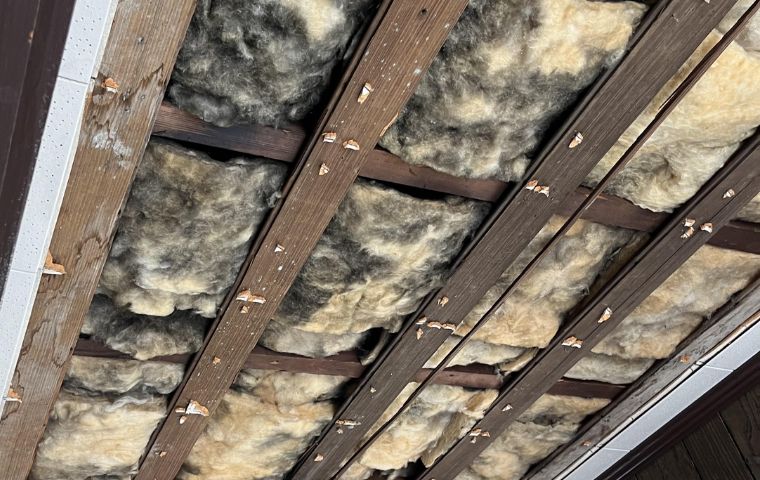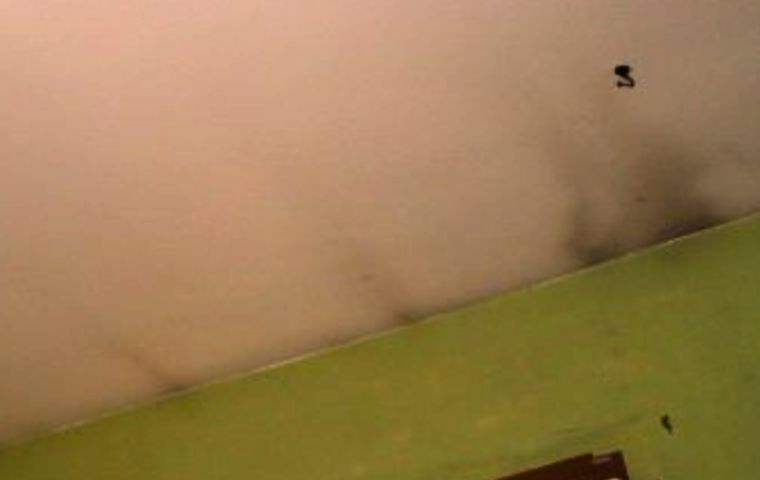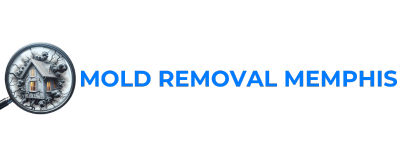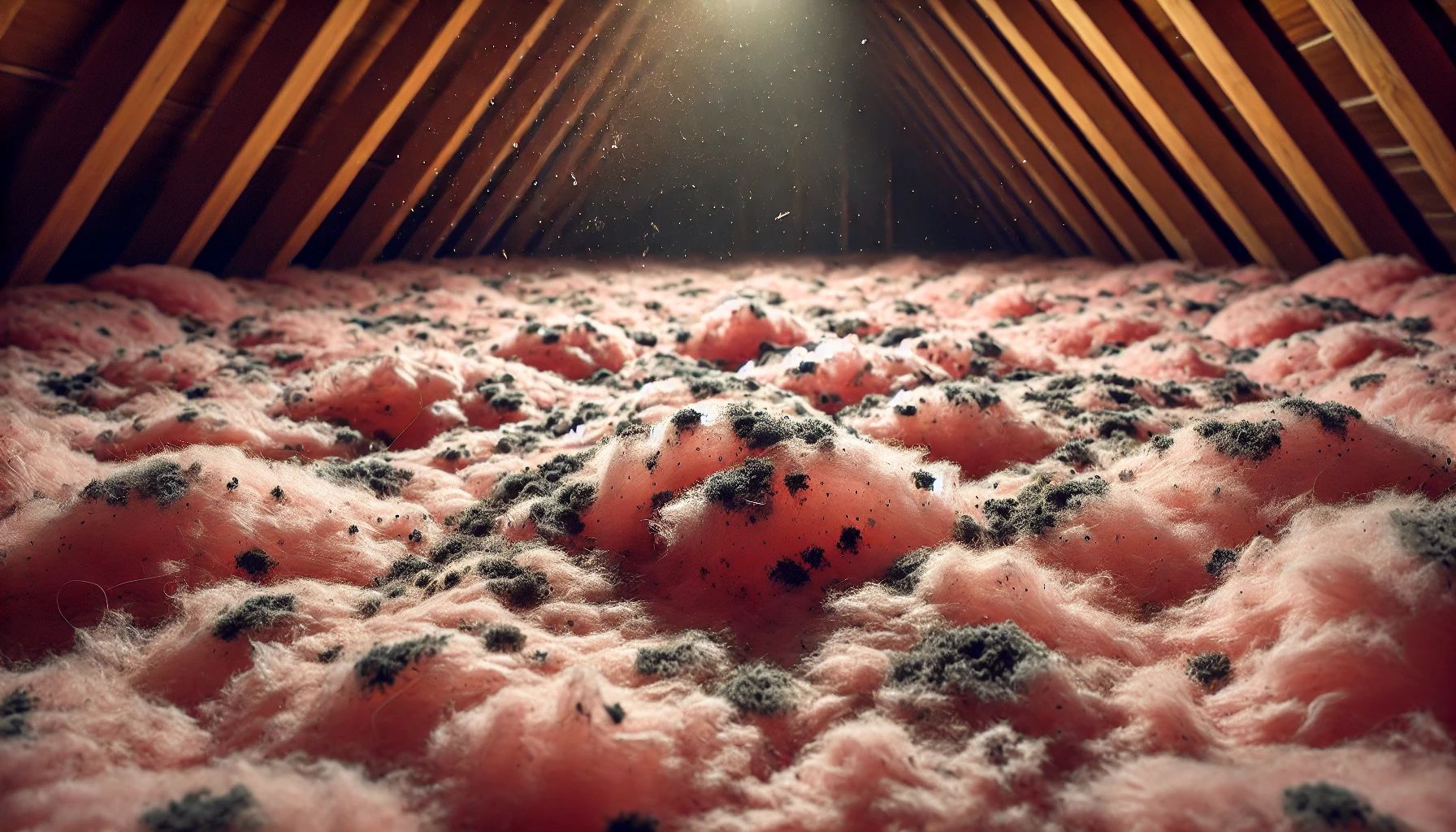Black Mold On Insulation: Causes, Signs, Effects And Prevention Tips
TL;DR: Black mold on insulation is a serious issue that can develop within 24-48 hours when moisture is present. It typically appears as dark spots or discoloration on fiberglass, cellulose, or spray foam insulation in attics, basements, and crawl spaces. While fiberglass itself doesn’t support mold growth, dust and organic materials on its surface can. Common causes include leaks, high humidity, condensation, and poor ventilation. Symptoms of mold exposure include coughing, sneezing, itchy skin, and respiratory problems. To address black mold, identify and fix moisture sources, improve ventilation, and maintain indoor humidity below 50%. Affected insulation often requires professional removal and replacement with mold-resistant alternatives like closed-cell foam or mineral wool. Costs for mold inspection range from $299 to $1,014, while remediation can cost between $1,125 and $3,439. You can use our mold removal cost calculator to estimate the black mold removal cost.
Finding black mold on insulation can be alarming for any homeowner. If you’ve noticed dark patches in your attic or behind drywall, it’s natural to have concerns about safety, removal, or whether you need to replace all your insulation. However, there’s no need to panic. Whether you’re facing a small area of mold or a more extensive issue, this guide will provide you with the essential information to address the situation effectively. Let’s explore how to manage mold in insulation problem and what steps to take next.
What Causes Black Mold On Insulation?
Black mold on insulation can arise from several factors, mainly linked to moisture and environmental conditions. High humidity, water leaks, and inadequate ventilation create the right environment for mold to thrive on insulating materials.
While fiberglass insulation itself usually doesn’t support mold growth, dust and organic materials trapped within it can serve as a food source. Issues with condensation, often caused by improper installation or a lack of vapor barriers, add to the dampness that encourages mold spores to develop.
In attics, roof leaks and insufficient airflow often lead to moisture accumulation and subsequent mold growth. Basements and crawl spaces are particularly vulnerable due to their tendency to retain dampness and often receive less attention.
Plumbing issues, elevated indoor humidity, and flooding can introduce water into insulated areas, which promotes the growth of mold. The type of insulation also matters. Cellulose-based materials are more likely to support fungal growth when wet, even if they have been treated with fungicides. Spray foam insulation can also be affected, as biofilms may develop on its surface if dust collects in moist conditions.
Thermal bridging can cause discoloration that may look like mold but isn’t necessarily fungal growth. However, if moisture persists from any source, genuine mold problems can develop within 24 to 48 hours. In areas like bathrooms and kitchens, poor ventilation combined with regular moisture from activities such as showering or dishwashing can lead to mold growth on nearby insulation.
Can Black Mold Grow On Insulation Materials?
Black mold can grow on insulation materials, and several things can affect this growth, like moisture levels, material type, and the environment. Different insulation materials react differently to mold based on their properties and conditions.
Cellulose insulation, made from wood fibers or recycled paper, is especially likely to develop mold. Since these materials are organic, they provide food for mold fungi, which break down cellulose into simpler parts. When humidity is high and temperatures are just right, mold is more likely to grow on cellulose insulation. Additives in insulation can also impact mold growth. For example, ammonium polyphosphate (APP) can encourage mold by providing nutrients like nitrogen and phosphates.
On the other hand, some additives, like boric acid, borax, and magnesium hydroxide, can help stop mold growth. Even in small amounts, boric acid and borax can slow down mold growth. Magnesium hydroxide works best when combined with APP.
Other types of insulation, like mineral wool (glass wool), resist mold better because they are made from inorganic materials. In conditions that would cause mold to grow on cellulose insulation, mineral wool stays unaffected, making it a better choice against mold. However, natural materials like hemp wool and modern options like aerogel blankets can be more prone to mold. Hemp wool is organic and provides food for mold, while aerogel blankets, even though they insulate well, can trap moisture and allow mold growth in high humidity or poor airflow.
Extruded polystyrene (XPS) insulation is good at resisting moisture, which lowers the risk of mold. This type of insulation helps keep indoor humidity low and wall surfaces warmer, both of which make it harder for mold to grow.
The thickness of insulation and the climate also play a role in mold growth. If the insulation is too thin or not suitable for the climate, it can lead to moisture buildup and mold problems.
A study has been conducted to look into the mold resistance of insulation made from wheat straw, corn stalk, and reed. These materials can absorb moisture, making them more likely to develop mold if not treated properly. Methods like thermo-mechanical pulping (TMP) and steam explosion pulping (SEP), along with antifungal treatments like boric acid and tetraborate, can help improve mold resistance. Samples treated with these methods showed less mold compared to untreated samples, proving that these treatments work.
Environmental conditions, such as temperature and humidity, are important for mold growth on insulation materials. Molds grow best within certain temperature and humidity ranges, and if conditions change too much, their growth can be affected.
Common molds found on insulation include Penicillium, Aspergillus, Cladosporium, and Acremonium. The specific types depend on the moisture levels and the materials used. Mold can also release volatile organic compounds (VOCs), which can hurt indoor air quality and indicate that mold is actively growing. Health experts recommend removing and replacing any materials with visible mold to avoid health problems such as breathing issues and asthma attacks.
Does Black Mold Only Grow On Wet Insulation?
Mold and Actinomycetes can grow on just about anything if it gets wet enough. The type of species that appears depends on how wet the material is and what it’s made of. Insulation in ducts or building walls often has spores from fungi that come from outdoor air. This can happen over time or even during construction. The molds that thrive on insulation are suited to its chemical makeup, and the specific species that grow rely on how much water is available.
No matter what nutrients are present in a material, the growth of microorganisms hinges on the availability of water. Generally, bacteria need liquid water to grow, while fungi can thrive in damp conditions because their cell walls are tougher. The growth of these organisms depends on having enough water, which scientists refer to as water activity (aw).
When insulation is in use but not wet, it still has fungi from plants and soil, regardless of the insulation type. However, when insulation does get wet, it tends to have a specific mix of fungi that is somewhat unique to that type of material.
Does Black Mold Affect Insulation Efficiency?
Black mold can significantly affect how well insulation works, causing both structural and thermal issues. When mold gets into insulation, it creates gaps and pockets in the material. This allows air to leak through, meaning the insulation isn’t doing its job. As a result, heating and cooling systems have to work harder to keep your home comfortable, leading to higher energy use and bigger utility bills.
Mold on insulation materials directly lowers their thermal resistance. When mold grows, it damages the surface and structure of the insulation, making it less effective at preventing heat transfer. This is especially harmful for materials like hemp wool and foams. Mold can break down the fibers in these materials. In this way, mold weakens their structure, due to which they possible require repairs or replacements to restore efficiency.
Cellulose insulation is particularly at risk for mold growth. Mold fungi produce enzymes called cellulase that break down cellulose, which makes up the insulation. As the mold eats away at the cellulose fibers, the insulation loses its strength and thermal resistance. This loss makes it even harder for the insulation to prevent heat transfer, leading to even more energy use.
What Does Black Mold Look Like In Insulation?

Black mold in insulation often shows up as dark spots or patches. These can range in color from deep gray to greenish-black. You might see these discolorations on different types of insulation, like fiberglass, spray foam, and paper-faced materials. Sometimes, they can look like soot or dirt, which makes it hard to tell just by looking at them.
In fiberglass insulation, mold usually grows on the paper backing or surface. That’s because the fiberglass itself doesn’t provide a food source for mold. On the other hand, spray foam insulation can develop mold if there’s a layer of dust or organic matter on it. When mold grows, it can look fuzzy or powdery in the affected areas.
It’s also important to note that thermal tracking stains can sometimes be confused with mold. These stains, which indicate air leaks or heat loss, often appear in patterns along joists or studs. Mold tends to thrive in places where moisture builds up, like attics, crawlspaces, and exterior walls. While it may come with a musty smell, that’s not always the case.

The amount of mold can vary widely, from just a few small spots to larger areas that cover a big part of the insulation. In serious cases, you might also see mold on nearby materials like wood studs or drywall.
How To Tell If Insulation Is Moldy Or Dirty?
To figure out if your insulation has mold or just dirt, follow these steps and look for some key signs:
Start by checking for moisture. Mold needs water to grow. If the area is dry and there are no signs of water damage on nearby wood, the discoloration is likely just dirt. Fiberglass insulation usually doesn’t grow mold because it has no organic material, but it can gather dust and dirt over time. Air leaks can cause dust to build up on insulation, especially at the edges where air flows.
Next, look at how the discoloration appears. If you see it mostly along the edges of the insulation, it’s probably dirt from air filtering through. Mold tends to spread more randomly. Also, pay attention to the color and texture. Mold often looks fuzzy or slimy, while dirt is usually powdery or grainy.
Think about the age and location of the insulation. Older insulation or insulation in areas with lots of air movement tends to collect more dust. In attics, dark spots on faced insulation might be tar adhesive used in the insulation’s making, not mold or dirt. This is especially true in dry climates.
Don’t forget to check for strange smells. Mold often gives off a musty odor, while dirt usually doesn’t smell much at all. However, just because there’s no smell doesn’t mean mold isn’t present.
For a clearer answer, you might want to take a small piece of the affected insulation out to inspect or test it. If the discoloration is only on the surface and brushes off easily, it’s likely dirt. Mold usually grows deeper into the material.
How To Prevent Black Mold On Insulation?
Stopping mold on insulation is all about keeping things dry and breezy. You’ve gotta watch out for dampness, make sure air’s moving around, and keep an eye on things. It’s important to use the right stuff when cleaning up mold and sometimes you might need to call in the pros.
Here are some tips to prevent mold on insulation:
Tip 1: Keep It Dry
Use a dehumidifier to suck moisture out of the air. Fix leaky pipes and roofs pronto. In the kitchen, make sure your backsplash keeps water out. When you’re putting in new insulation, go for the kind that fights moisture, like rockwool. Don’t forget to put in a good vapor barrier too.
Tip 2: Let The Air Flow
Open windows a bit to let air move. Use exhaust fans in kitchens and bathrooms. In attics, check that soffit vents aren’t blocked and think about adding ridge or gable end vents. Make sure bathroom fans vent outside, not into the attic. Good airflow helps keep things dry and mold-free.
Tip 3: Regular Inspections And Maintenance
Keep an eye out for damp spots or musty smells. Use an infrared thermometer to find cold areas where insulation might be thin and condensation could form. If you spot wet insulation, take it out right away. Don’t wait for mold to grow.
Tip 4: Clean It Right
If you spot mold, don’t just splash some bleach on it. That won’t cut it. Use special mold-killing stuff like Concrobium. Or mix up some soap and hydrogen peroxide. When you’re cleaning, wear gloves and a mask, and close off the area so mold doesn’t spread.
Tip 5: Professional Help
For big mold problems or if you’re not sure what to do, contact mold remediation pros. They can check your ventilation, insulation, and look for hidden mold behind walls. Sometimes, what you see is just the tip of the iceberg, and you need expert help to fix the real problem.
Should Moldy Insulation Be Removed?
Moldy insulation should usually be removed to keep people healthy and maintain the home’s structure. When insulation gets contaminated, it can trap harmful spores that may cause respiratory problems, allergies, and other health issues, especially for those with asthma or weak immune systems. Moisture can seep into insulation, creating a perfect spot for mold to grow. This not only affects the insulation’s ability to keep the home warm but can also spread mold to nearby building materials.
We typically advise replacing wet or visibly moldy insulation instead of trying to clean it. Mold can dig deep into porous materials, making it hard to fully remove. When taking out the insulation, we advise wearing protective gear like respirators, goggles, and gloves to avoid breathing in spores and fibers.
After removing the affected insulation, you should fix the moisture problem, whether it’s due to leaks, condensation, or poor ventilation. This helps stop mold from coming back. Also, be sure to check and clean nearby areas, like wood framing and drywall, before putting in new insulation.
While the costs of removal and replacement might seem high, it’s often a necessary step to ensure a healthy home and keep the building strong in the long run. Our mold removal experts recommend looking into different insulation options, like closed-cell spray foam or mineral wool. These materials can resist moisture better, making them a smart choice for damp areas.
Can You Spray Foam Insulation Over Mold?
Spraying foam insulation over mold is something that can be done, but we really don’t recommend it. Premium closed-cell spray foam insulation doesn’t feed mold and can even kill some mold spores because of the heat it generates during application. However, it doesn’t fix the moisture problems that cause mold to grow in the first place. If you just spray foam over mold without properly dealing with it, you could end up with serious issues later on.
When foam is applied over mold, it can trap moisture, which allows the mold to keep damaging the structure underneath. This can lead to hidden damage, health risks from mold particles, and expensive repairs down the road. Plus, spray foam is meant to be a long-lasting solution, so if mold issues come back after installation, it can be hard to reach and treat them.
Before you think about applying any insulation, you need to take care of the mold first. This means finding and fixing the source of moisture, thoroughly cleaning and treating the affected areas, and making sure everything is completely dry. Experts suggest getting mold professionally removed and documented before you apply spray foam insulation. For the best results, the moisture content of surfaces should be 18% or less to ensure the foam sticks well and works properly.
In today’s world, it’s important to have certified mold removal professionals take care of mold treatment to avoid any potential legal problems. While spray foam provides great insulation and helps seal air leaks, it should never be used as a quick fix to hide mold issues.
What Insulation Is Mold-resistant?
Mold-resistant insulation options include mineral wool, closed-cell spray foam, extruded polystyrene (XPS), and treated fiberglass. These materials resist moisture and prevent fungal growth in homes and vehicles.
Here are different types of insulation that can resist mold growth:
Mineral Wool (Rock Wool)
Mineral wool, also called rock wool, is a highly effective mold-resistant insulation option. It retains its insulating properties even when exposed to moisture. This makes it ideal for damp-prone areas. This material does not provide a food source for mold and allows for proper ventilation, reducing the risk of condensation and subsequent fungal growth.
Closed-Cell Spray Foam
Closed-cell spray foam insulation creates a robust barrier against water vapor, significantly reducing the risk of condensation and mold formation. Its dense structure prevents moisture penetration and air movement, making it an excellent choice for areas with high humidity or potential water exposure. This type of insulation adheres well to surfaces. It ensures comprehensive coverage and minimizing gaps where mold could potentially grow.
Extruded Polystyrene (XPS)
XPS is a rigid foam insulation that offers excellent mold resistance due to its closed-cell structure. It effectively resists water absorption and vapor transmission. This makes it suitable for use in basements, exterior walls, and other moisture-prone areas. XPS maintains its insulating properties and structural integrity even when exposed to damp conditions, providing long-lasting protection against mold growth.
Moisture-Resistant Fiberglass
While traditional fiberglass can support mold growth if it becomes wet, specially treated moisture-resistant variants are available. These products often incorporate fungicides or are manufactured without organic components that could serve as a food source for mold. When properly installed and paired with effective moisture management strategies, moisture-resistant fiberglass can provide reliable protection against fungal infestations.
Thinsulate
Thinsulate, commonly used in van conversions and other compact living spaces, offers good mold resistance properties. It helps manage condensation and moisture in confined areas. So, it reduces the risk of mold growth. However, proper ventilation and moisture control measures are still essential when using Thinsulate, especially in high-humidity environments.
DensArmor Plus Drywall
While not an insulation material itself, DensArmor Plus is a mold-resistant drywall option often used in conjunction with insulation in moisture-prone areas. It features a moisture-resistant core and fiberglass mats instead of paper facings. This makes it less susceptible to mold growth compared to traditional drywall. This product is particularly useful in basements and other areas with potential moisture issues.
Worried About Mold On Your Insulation? Get Expert Help Today!
Dealing with mold on insulation requires more than just a quick fix. If you’ve noticed black mold or suspicious discoloration in your attic, basement, or crawl spaces, our mold removal team is here to help. We specialize in safe and effective mold remediation, removing mold from insulation and preventing it from coming back. Don’t let mold compromise your home’s air quality or energy efficiency — contact us today to schedule a professional inspection and take the first step toward a healthier living environment.

